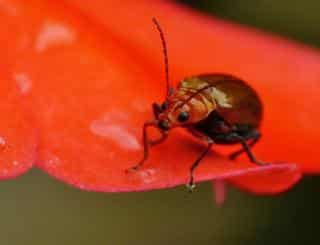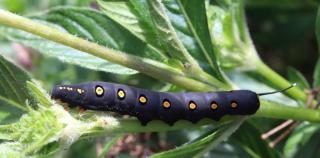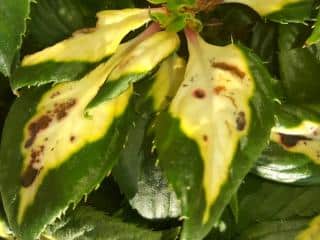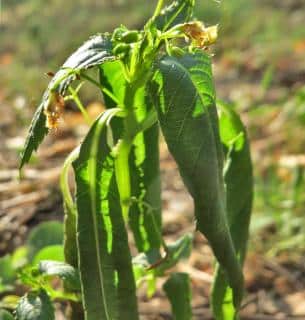

Sunpatiens is a type of impatiens bred to resist most diseases. However, it still occasionally falls sick and has to deal with pests!
More about sunpatiens:
 Although generally not so vulnerable to diseases and parasites, occasionally you’ll notice an invasion of red spider mites, thrips or aphids on your impatiens.
Although generally not so vulnerable to diseases and parasites, occasionally you’ll notice an invasion of red spider mites, thrips or aphids on your impatiens.
Shown here is the pumpkin beetle, which is quite harmless for sunpatiens.
A good way to get rid of all three is to hose the plant down with a nozzle. Test it on a small portion first to adjust the strength of the spray: Sunpatiens leaves and stems are softer than those of most other plants! A spray that is too strong will rip leaves off from the plant.
If holes appear on the leaves of your sunpatiens ®, be on the lookout for slugs because they love this type of plant and you must act fast.
If you notice leaves disappearing entirely, there might be a few caterpillars hiding underneath.

Unlike common Impatiens, Sunpatiens ® lineage was selected and bred to resist downy mildew. That’s what usually kills impatiens flowers, but Sunpatiens is immune to it!
Although it comes from Impatiens varieties that were resistant to most types of diseases, a Sunpatiens plant may contract certain root rot fungus when growing conditions aren’t ideal. Different molds or fungus infect the flower, especially if weakened by lack of water. These include common soil pathogens such as Rhizoctonia and Pythium.
Young, freshly planted Sunpatiens might contract a disease caused by gray mold, Botrytis cinerea. This is a type of mold that breaks organic matter down. Sunpatiens flower petals are thin and fragile, they’re more easily infected than other parts of the plant.

To counter this blight:
The coldest temperature a Sunpatiens plant can survive is 32°F (0°C), and then only for a couple hours. This plant doesn’t have any coping against freezing. Cells burst when water inside them turns to ice, even for just an hour of morning frost. Winterize the plant diligently to protect it from the cold.
Symptoms of freezing include :

The wilting is a symptom of light water stress. This stress diverts energy to the root system to expand and strengthen it. Having the habit of only watering when you notice that slight wilt is the best thing you can do for your sunpatiens!
Impatiens naturally evolved as a shade plant. Although sunpatiens is derived from impatiens, it’s astounding to see this hybrid easily thrive in such full sun and hot temperatures!
In regions where the air is very dry and hot, your sunpatiens might be vulnerable to leaf scorch. This only happens if the plant lacks water for more than couple days. Make sure to water diligently and, if needed, set up a constant drip irrigation system.
I have raised these in large, well drained containers for 3 years.
Every year several plants get some
disease that causes them to get gnarly and stop blooming.
Would appreciate suggestions on what to apply to prevent this disease.
Hi Bill,
gnarly leaves are often a sign of either some type of leaf curl, or an infestation of tiny bugs. Are there any aphids, scale insects, or mites? Sometimes they’re quite small and you need a magnifying glass to see them.
To get rid of them, a good first step is to spray leaves with water. Put a little force on the water to dislodge them, but not too much so the leaves aren’t ripped off.
Other options are described here: aphids, scale, mites. They describe many different products and tips to deal with these pests.
There is a chance that your sunpatiens is diseased, but for that it’s really important to have good pictures. If a plant is dying out, try including a picture of its roots, too.